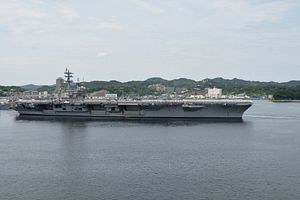USS Ronald Reagan, the only forward-deployed U.S. Nimitz-class supercarrier, departed the U.S. naval base in Yokosuka, Japan on May 29 for a regularly scheduled patrol to operate in the western Pacific Ocean, the U.S. Navy said in a statement.
“Ronald Reagan Strike Group will be conducting training in the U.S. 7th Fleet area of operations supporting security and stability in the Indo-Pacific region,” the service said.
“[Ronald Reagan Strike Group] is very excited to get underway and begin to train and operate together, as well as with our allies and partners,” said Rear Admiral Marc Dalton the commander of Task Force 70. “As we get underway for these operations we will continue to represent the United States as the security partner of choice in the region, to ensure freedom of the seas, drive stability and security and to promote adherence to a rules-based international order.”
The carrier’s escort includes the Arleigh Burke-class guided-missile destroyer USS Mustin (DDG 89) and the Ticonderoga-class guided-missile cruisers USS Antietam (CG 54) and USS Chancellorsville.
Every carrier strike group (CSG) is also accompanied by one or two nuclear-powered fast attack submarines. (The U.S. Navy usually does not comment on the movement and deployment schedule of its submarine force.) A carrier strike group can consist of up to 12 surface ships and around 75 aircraft.
The service has neither announced any port calls nor specified the CSG’s first destination. It has also not publicized what bilateral and multilateral naval drills the Ronald Reagan CSG will participate will in.
As I reported last year, the Ronald Reagan CSG participated in a naval exercise in the waters off the Korean Peninsula in October 2017. In June, the USS Ronald Reagan and another Nimitz-class carrier, the USS Carl Vinson, conducted a joint naval exercise off the Korean peninsula in the Sea of Japan in response to North Korean ballistic missile tests. It was the first time that two U.S aircraft carriers were operating near the Korean Peninsula since the 1990s.
In November 2017, the USS Ronald Reagan, along with two other Nimitz-class flattops USS Nimitz, and USS Theodore Roosevelt, held a rare four-day naval drill in the Western Pacific. The naval exercise was the first in a decade in the region to involve a three-carrier strike force. Three CSGs last operated together in the western Pacific region during exercise Valiant Shield off the coast of Guam in 2006 and 2007 respectively.
While deployed in the Sea of Japan in October 2017, F/A-18 Hornet fighter jets from the Ronald Reagan had to intercept two Russian nuclear-capable Tupolev Tu-95MS strategic bombers approaching the CSG.
The USS Ronald Reagan conducted sea trials earlier this month following a four-month maintenance period. The carrier had been in Yokusuka naval base since December 2017. The Ronald Reagan originally arrived in Yokosuka to replace USS George Washington, the former forward-deployed U.S. supercarrier in Japan in 2015.

































